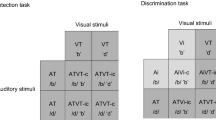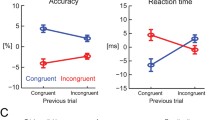Abstract
Multisensory integration (MSI) is a phenomenon that occurs in sensory areas after the presentation of multimodal stimuli. Nowadays, little is known about the anticipatory top-down processes taking place in the preparation stage of processing before the stimulus onset. Considering that the top-down modulation of modality-specific inputs might affect the MSI process, this study attempts to understand whether the direct modulation of the MSI process, beyond the well-known sensory effects, may lead to additional changes in multisensory processing also in non-sensory areas (i.e., those related to task preparation and anticipation). To this aim, event-related potentials (ERPs) were analyzed both before and after auditory and visual unisensory and multisensory stimuli during a discriminative response task (Go/No-go type). Results showed that MSI did not affect motor preparation in premotor areas, while cognitive preparation in the prefrontal cortex was increased and correlated with response accuracy. Early post-stimulus ERP activities were also affected by MSI and correlated with response time. Collectively, the present results point to the plasticity accommodating nature of the MSI processes, which are not limited to perception and extend to anticipatory cognitive preparation for task execution. Further, the enhanced cognitive control emerging during MSI is discussed in the context of Bayesian accounts of augmented predictive processing related to increased perceptual uncertainty.






Similar content being viewed by others
Data availability
The datasets generated during and/or analyzed during the current study are available from the corresponding author on reasonable request.
References
Beauchamp MS (2005) Statistical criteria in fMRI studies of multisensory integration. Neuroinformatics 3:93–113
Beauchamp MS, Lee KE, Argall BD, Martin A (2004) Integration of auditory and visual information about objects in superior temporal sulcus. Neuron 41:809–823
Berchicci M, Lucci G, Pesce C, Spinelli D, Di Russo F (2012) Prefrontal hyperactivity in older people during motor planning. Neuroimage 62(3):1750–1760
Berchicci M, Pontifex MB, Drollette ES, Pesce C, Hillman CH, Di Russo F (2015) From cognitive motor preparation to visual processing: the benefits of childhood fitness to brain health. Neuroscience 298:211–219
Berchicci M, Spinelli D, Di Russo F (2016) New insights into old waves. Matching stimulus-and response-locked ERPs on the same time-window. Biol Psychol 117:202–215
Berchicci M, Ten Brink AF, Quinzi F, Perri RL, Spinelli D, Di Russo F (2019) Electrophysiological evidence of sustained spatial attention effects over anterior cortex: possible contribution of the anterior insula. Psychophysiology 56(7):e13369
Bianco V, Perri RL, Berchicci M, Quinzi F, Spinelli D, Di Russo F (2020a) Modality-specific sensory readiness for upcoming events revealed by slow cortical potentials. Brain Struct Funct 225(1):149–159
Bianco V, Berchicci M, Livio Perri R, Quinzi F, Mussini E, Spinelli D, Di Russo F (2020b) Preparatory ERPs in visual, auditory, and somatosensory discriminative motor tasks. Psychophysiology 57(12):e13687
Busse L, Roberts KC, Crist RE, Weissman DH, Woldorff MG (2005) The spread of attention across modalities and space in a multisensory object. Proc Natl Acad Sci 102(51):18751–18756
Calvert GA, Bullmore ET, Brammer MJ, Campbell R, Williams SC, McGuire PK, David AS (1997) Activation of auditory cortex during silent lipreading. Science 276(5312):593–596
Choi I, Lee JY, Lee SH (2018) Bottom-up and top-down modulation of multisensory integration. Curr Opin Neurobiol 52:115–122
Di Russo F, Berchicci M, Bozzacchi C, Perri RL, Pitzalis S, Spinelli D (2017) Beyond the “Bereitschaftspotential”: action preparation behind cognitive functions. Neurosci Biobehav Rev 78:57–81
Di Russo F, Berchicci M, Bianco V, Perri RL, Pitzalis S, Quinzi F, Spinelli D (2019) Normative event-related potentials from sensory and cognitive tasks reveal occipital and frontal activities prior and following visual events. Neuroimage 196:173–187
Faul F, Erdfelder E, Lang AG, Buchner A (2007) G* Power 3: a flexible statistical power analysis program for the social, behavioral, and biomedical sciences. Behav Res Methods 39(2):175–191
Feldman JI, Dunham K, Cassidy M, Wallace MT, Liu Y, Woynaroski TG (2018) Audiovisual multisensory integration in individuals with autism spectrum disorder: a systematic review and meta-analysis. Neurosci Biobehav Rev 95:220–234
Fiorini L, Berchicci M, Mussini E, Bianco V, Lucia S, Di Russo F (2021) Neural basis of anticipatory multisensory integration. Brain Sci 11(7):843
Fiorini, L., Di Russo, F., Lucia, L., Bianco, V. (2022). Modality predictability modulation confirms the sensorial readiness function of the pre-stimulus activity in sensory brain areas. Cortex, in press.
Foxe JJ, Morocz IA, Murray MM, Higgins BA, Javitt DC, Schroeder CE (2000) Multisensory auditory–somatosensory interactions in early cortical processing revealed by high-density electrical mapping. Cogn Brain Res 10:77–83
Friston, K. (2005) A theory of cortical responses. Philosophical Transactions of the Royal Society of London. B Biological Sciences, 360 (1456) 815–836.
Giard MH, Peronnet F (1999) Auditory-visual integration during multimodal object recognition in humans: a behavioral and electrophysiological study. J Cogn Neurosci 11(5):473–490
Macaluso E (2006) Multisensory processing in sensory-specific cortical areas. Neuroscientist 12(4):327–338
Laurienti PJ et al (2003) Cross-modal sensory processing in the anterior cingulate and medial prefrontal cortices. Hum Brain Mapp 19:213–223
Li Y, Seger C, Chen Q, Mo L (2020) Left inferior frontal gyrus integrates multisensory information in category learning. Cereb Cortex 30(8):4410–4423
Luck SJ, Gaspelin N (2017) How to get statistically significant effects in any ERP experiment (and why you shouldn’t). Psychophysiology 54:146–157
Mangun GR, Buck LA (1998) Sustained visual-spatial attention produces costs and benefits in response time and evoked neural activity. Neuropsychologia 36(3):189–200
Martínez-Sanchis S (2014) Neurobiological foundations of multisensory integration in people with autism spectrum disorders: the role of the medial prefrontal cortex. Front Hum Neurosci 8:970
Matusz PJ, Eimer M (2013) Top-down control of audiovisual search by bimodal search templates. Psychophysiology 50(10):996–1009
Molholm S, Ritter W, Murray MM, Javitt DC, Schroeder CE, Foxe JJ (2002) Multisensory auditory–visual interactions during early sensory processing in humans: a high-density electrical mapping study. Cogn Brain Res 14(1):115–128
Morís Fernández L, Macaluso E, Soto-Faraco S (2017) Audiovisual integration as conflict resolution: the conflict of the McGurk illusion. Hum Brain Mapp 38:5691–5705
Mussini E, Berchicci M, Bianco V, Perri RL, Quinzi F, Di Russo F (2021) Effect of task complexity on motor and cognitive preparatory brain activities. Int J Psychophysiol 159:11–16
Quinzi F, Berchicci M, Bianco V, Perri RL, Di Russo F (2019) The independency of the Bereitschaftspotential from previous stimulus-locked P3 in visuomotor response tasks. Psychophysiology 56(3):e13296
Ramkhalawansingh R, Keshavarz B, Haycock B, Shahab S, Campos JL (2016) Age differences in visual-auditory self-motion perception during a simulated driving task. Front Psychol 7:595
Romanski LM, Hwang J (2012) Timing of audiovisual inputs to the prefrontal cortex and multisensory integration. Neuroscience 214:36–48
Salmaso D, Longoni AM (1985) Problems in the assessment of hand preference. Cortex 21(4):533–549
Santangelo V, Van der Lubbe RHJ, Belardinelli MO, Postma A (2008) Multisensory integration affects ERP components elicited by exogenous cues. Exp Brain Res 185(2):269–277
Scheliga S, Kellermann T, Lampert A, Rolke R, Spehr M, Habel U (2022) Neural correlates of multisensory integration in the human brain: an ALE meta-analysis. Rev Neurosci. https://doi.org/10.1515/revneuro-2022-0065
Spence C, Shore DI, Klein RM (2001) Multisensory prior entry. J Exp Psychol 130:799
Stephen JM, Knoefel JE, Adair J, Hart B, Aine CJ (2010) Aging-related changes in auditory and visual integration measured with MEG. Neurosci Lett 484:76–80
Stevenson RA, Ghose D, Fister JK, Sarko DK, Altieri NA, Nidiffer AR, Wallace MT (2014) Identifying and quantifying multisensory integration: a tutorial review. Brain Topogr 27(6):707–730
Talsma D, Senkowski D, Soto-Faraco S, Woldorff MG (2010) The multifaceted interplay between attention and multisensory integration. Trends Cogn Sci 14(9):400–410
Talsma D, Woldorff MG (2005) Selective attention and multisensory integration: multiple phases of effects on the evoked brain activity. J Cogn Neurosci 17:1098–1114
Tang X, Wu J, Shen Y (2016) The interactions of multisensory integration with endogenous and exogenous attention. Neurosci Biobehav Rev 61:208–224
Teder-Sälejärvi WA, Di Russo F, McDonald JJ, Hillyard SA (2005) Effects of spatial congruity on audio-visual multimodal integration. J Cogn Neurosci 17(9):1396–1409
Teder-Sälejärvi WA, McDonald JJ, Di Russo F, Hillyard SA (2002) An analysis of audio-visual crossmodal integration by means of event-related potential (ERP) recordings. Cogn Brain Res 14(1):106–114
Van Atteveldt N, Murray MM, Thut G, Schroeder CE (2014) Multisensory integration: flexible use of general operations. Neuron 81(6):1240–1253
Visalli A, Capizzi M, Ambrosini E, Kopp B, Vallesi A (2021) Electroencephalographic correlates of temporal Bayesian belief updating and surprise. Neuroimage 231:117867
Wassenhove VV, Grant KW, Poeppel D, Halle M (2005) Visual speech speeds up the neural processing of auditory speech. Proc Natl Acad Sci USA 102:1181–1186
Williams LE, Light GA, Braff DL, Ramachandran VS (2010) Reduced multisensory integration in patients with schizophrenia on a target detection task. Neuropsychologia 48:3128–3136
Zikopoulos B, Barbas H (2007) Circuits for multisensory integration and attentional modulation through the prefrontal cortex and the thalamic reticular nucleus in primates. Rev Neurosci 18(6):417–438
Funding
This study was supported by the University of Rome “Foro Italico” grant CDR2.BANDO2020DRF to FDR.
Author information
Authors and Affiliations
Contributions
FDR and VB conceptualized and designed the study. Material preparation, data collection, and analysis were performed by SL, LF, and EM. The first draft of the manuscript was written by SL and FDR and all authors commented on previous versions of the manuscript. All authors read and approved the final manuscript.
Corresponding author
Ethics declarations
Conflict of interest
The authors have no relevant financial or non-financial interests to disclose.
Additional information
Publisher's Note
Springer Nature remains neutral with regard to jurisdictional claims in published maps and institutional affiliations.
Rights and permissions
Springer Nature or its licensor (e.g. a society or other partner) holds exclusive rights to this article under a publishing agreement with the author(s) or other rightsholder(s); author self-archiving of the accepted manuscript version of this article is solely governed by the terms of such publishing agreement and applicable law.
About this article
Cite this article
Lucia, S., Aydin, M., Bianco, V. et al. Effect of anticipatory multisensory integration on sensory–motor performance. Brain Struct Funct 229, 549–559 (2024). https://doi.org/10.1007/s00429-023-02620-3
Received:
Accepted:
Published:
Issue Date:
DOI: https://doi.org/10.1007/s00429-023-02620-3




